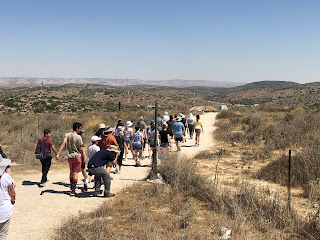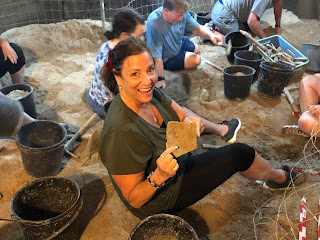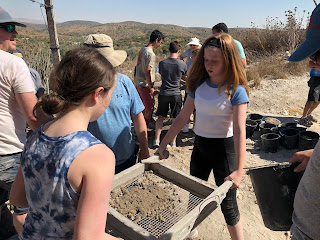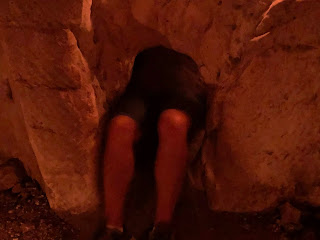Happy 4th of July! I apologize that I am creating this post a
day late. Truth be told, these Jerusalem
days start REALLY early and are ending so late at night because there is so
much to see. I really needed to take a
night and get to bed a little early because tomorrow (Friday, July 5) we leave
the hotel at 6:45 am to get to Masada.
So please forgive me for this! I
also think that today was such an emotional one, I needed time to process all I
had seen, and all I watched our traveling families experience.
Our day began early with a discussion with Dr. Rachel
Korazim, a Holocaust scholar and educator.
She set the stage for our traveling family as to what we
would experience at Yad Vashem. She had
some amazing insights for us, like the fact that all of the photos we would be
seeing were either taken by Nazi soldiers (who wanted to show the Jews as less
than human) and by the liberating soldiers, who saw us at our very worst. In both cases, our humanity was stripped from
us because no one asked “Hey, can we take your picture?” The photos were taken, and needed to be taken,
so we could bear witness, against our will and at the time in our lives where
we would have never wanted a photo taken.
She also talked about how all the photos were in black and white because
color photos were so expensive to develop.
But this makes it feel like the photos are taken from another time in
history, older than it actually is. She
wanted us to remember that even though the photos were in black and white the
world was actually very much in color.
The sky was not grey, it was blue.
Little girls wore colored ribbons in their hair. This brought a new sense of reality to
us. And, she made a comment that really
stuck with me. She explained how every
person is taught the number 6 million.
However, when she asked us how many names of victims we could mention,
it was relatively few. Her reminder, as
was Uri’s throughout the morning, was that it was not 6 million Jews that died
in the Holocaust. It was one single Jew,
one person who died 6 million times. This
focus on the individual is something I teach when I educate about the
Holocaust. It is also something that Yad
Vashem does so well, helps us each to focus on the individual.
After our discussion with Dr. Korazim, we made our way to the
Yad Vashem complex, the Jewish National Memorial to the six million Jewish
victims of the Holocaust. My heart grew
heavy as our bus approached the mountain where this complex is located. Heavy because I knew that I would be bringing
a new reality to those traveling with me who had never seen this place
before. Heavy because for most of the
kids in our group, this would be the most in depth and graphic look at man’s
inhumanity to other people, at the same baseless hatred that brought down the
Second Temple. I watched Hayley closely
to see how she would take this in.
Yad Vashem is a beautiful place, and I love the fact that
Uri began our tour with the Avenue of the Righteous, a forest of trees, each
planted in honor of those non-Jews who risked their lives and their family’s
lives to help Jewish strangers.
Uri challenged us to think about how difficult a choice it
would be to help a stranger whose life was in danger. On the surface, it is a no-brainer. Of course we help. Of course we try to hide Jewish families we
don’t know in our home. Of course… Until we realize that helping puts the lives
of not only ourselves, but our children at risk. Would you help knowing that if you got caught
your entire family would be exterminated just like the Jews? The Avenue of the Righteous is such an
important place to start because on this hill there is an entire forest of
those who did make the choice to help.
And today, there are generations of Jews who are here because of the
bravery represented by these trees. It
is an inspiring site, each tree with a plaque honoring those righteous gentiles
who risked everything to help. How
amazing that where we start is not about death at all, but the preservation of
life.
And then, we entered the museum.
Again, I am grateful that I was not allowed
to take photos inside the museum, so I could take it in myself. Normally, during trips I lead like this Uri is
at the front of the line and I am at the back, making sure that all of our
travelers are between him and me, to be sure no one gets left behind. But here, at Yad Vashem, I needed to be more
of a dad to Hayley today than a leader for our group. I needed to be near to her when she would
need me for an embrace, or to let her know it was ok. Even though I knew it wasn’t ok. Hayley has always felt things on a different
level, a much deeper level than someone her age normally does. While this seems like it would be a good
thing, it also works against her as she internalizes other’s feelings to the
point of allowing it to get in the way of her own… How would she internalize the reality of the
horror of the Holocaust?
There are no words to describe experiencing this place. Just like there are no words to describe what
happened during World War 2. Uri was
able to make the Holocaust tangible for us to understand and his passion for
Jewish education comes through clearly as he carefully guides us through this
museum and explains the details, sometimes difficult and unthinkable, to each
one of us. I am grateful for his
expertise and his ability to connect with our group on every level, and his
ability to present the facts to us in a gentle way, and in an honest way. With each step I could see Hayley’s heart
getting heavier and heavier. There were
times she would just reach out and wrap her arms around me in a tight embrace. No words were necessary, and in her hug I
could feel her anguish. And my tears
would flow.
There are many moments that stick out for me in the
museum. This is the 4th time
I have visited, and I am struck by the same photographs each time, and my eyes
catch new ones with each visit. I am
always impacted greatly by the antisemitic board game that children used to
play prewar. It was just one example of
such baseless hatred for a people. I am
also always impacted at the room where they have the yellow stars on display. This act if separating us out from the rest
of the world, another act of removing our humanity is always so hard for me to
see.
Another stop in the museum that always impacts me is the
photo evidence of the beginning of the killing through the einzatzgruppen, the
Nazi death squads, especially this one photo of a parent clinging to a child as
a soldier was standing with the rifle pointing at them. At first, I am struck by the way the parent
is shielding the child from the rifle, even though looking at the picture you
know the fate of both. But this time,
after our talk with Dr. Rachel Korazim this morning, my thoughts were on the
photographer. How could someone take
this photo? What were they
thinking? Were they horrified at what
they saw? I will, unfortunately, never
find out the answers to these questions.
In another room, as Uri was talking to the group, one of our
younger travelers, Sammy, was sitting on the floor next to a display showing
photos of children during the Holocaust.
And in one photo, the child was sitting in the same position Sammy was
in, and he was wearing his yellow star as was the law. I first noticed how Sammy and this child were
in the exact same position. Then I
noticed the yellow star. And then I saw
the big Jewish star necklace Sammy was wearing.
One child was wearing a star as a badge of shame and another as a badge
of honor. One had little hope for their
future, while the other has so many opportunities to look forward to. I pray that all of these kids on this trip
realize how lucky they are to be living at a time where we are relatively safe,
and where we still have the ability to stand up for those who cannot stand up
for themselves. I think of all the
souvenirs Hayley has bought on this trip, and all the signs that proudly states
that she is a Jew. May she always be
able to wear these with pride. Another
long embrace with Hayley. This time, she
is comforting me.
As Uri weaves the story of the Holocaust for us, there are
countless moments I could recall for you, but, again, words do not do the
experience justice. So I will only say
that I think you should all come and experience this for yourself.
As we walked through I knew we were coming to the room that
always hits me the hardest.
In this circular room called the Hall of Names, there are
countless binders where all of the victims of the Holocaust are listed. In each binder is a page that represents one
victim. Every victim was registered by
someone living who manually entered them into the database. There are countless binders on these
shelves. Everywhere you look is another
binder. So far, according to Uri, there
are 4.2 million names recorded in this database. But look at this photo…
While the binders are heartbreaking, the empty shelves are
unthinkable. If 6 million Jews were
murdered why have 4.2 million names been recorded? Why not more?
Because the reality is that entire families were destroyed by Hitler’s
killing machine and there is no one left to remember them. The reality that those shelves will always
remain empty leaves such a pit in my stomach that I do not even hear myself
weeping. And I look and see that Hayley
is weeping, too. Somewhere, on one page
in one of these binders is the name Hermi van Hasselt, Hayley’s Holocaust twin. And on another is Sophia van Hasselt, Carly’s
Holocaust twin. And I wonder if the
other 9 kids who are becoming b’nai mitzvah this Saturday morning realize that
their Holocaust twins are also on these pages.
The weight of the loss is too much to bear. Think of all the potential that was lost in
those pages, and the generations that would never come to be because of the
loss of these innocent people who were the victims of baseless hate. Another huge embrace with Hayley, this time,
we are comforting each other.
We make our way out of the museum to this view…
While the reality of the Holocaust is overwhelming, Uri is
here to remind us that, even with this weight, Judaism has survived. Nazism has fallen, but Judaism is
strong. We needed that reminder that
even though people have tried to destroy us, we are stronger than their
hate. And we all have a choice to
make. Judaism is like a chain link
fence, with each of us adding our link to the chain. What choice will we make? I hope and pray that our travelers, and
perhaps you reading this at home, will make the choice to help strengthen the
chain of Judaism. I know I am inspired
to do so.
We make our way from the museum to the Children’s
Memorial. The first thing you notice is
the pillars at the top of the memorial.
Uri explained it like these are kids lining up for a class
photo, each in perfect lines, and each pillar broken, representing the lives of
these precious children cut short. More
tears. Another hug.
I will not share with you the details of the Children’s
Memorial. It is something that defies
explanation. What I will tell you is
that each time I walk through this memorial I am different when I exit. It truly is one of those life-defining
moments for me.
Following this we gathered in front of the Janusz Korczak
statue to do a brief memorial service.
I
love this space because when I was in Poland, some 3 and a half years ago, we visited
his orphanage in Warsaw and learned all about his story and how he comforted
all of the children in his care as he and they were led into the gas chambers
at Treblinka. Even though he could have
saved himself, he chose to be that source of comfort for those children whose
fate was sealed by the Final Solution.
In front of his statue and memorial, we prayed and wept as a
community. It felt good to be with my
community in prayer after such an experience.
Following our visit at Yad Vashem, we made our way to a
truly unique and amazing experience in Israel, as we took part in an
archeological dig at the Beit Guvrin Caves.
At first it seems inappropriate that we go from such a heavy and
emotional experience to one that is so much fun, but, in reality it was
important for us to do this. It is so
easy to get weighted down by the Holocaust.
If we allow it to consume us and define who we are, it is as if we are
giving Hitler a posthumous victory.
Instead, we need to hold the memories close to our hearts, to hold the 1
Jew that died 6 million times close to us and make the choice to live. What better way to say with a clear and
strong voice that Hitler lost then by fully enjoying the rest of our trip to
Israel?
The archeological dig is not a staged activity. We participated in an actual dig, as we got
our hands dirty and uncovered pottery and other items from the Hellenistic
period, 2300 years ago. In other words,
we were the first humans to find and hold these items in 2300 years, since the
time of the Macabees! This is an
incredible experience!
During our dig we found many items, including countless
pieces of pottery, bones from the food that was consumed, charred remnants from
the fires that were built, and even some special items. Hayley found a tooth and a piece of
glass! The glass was put into a place
called “special findings” as glass from this period is an extremely rare
find.
Following the dig, we sifted through the dirt we pulled from
the caves to find more treasures.
And then, those who were interested crawled through the
Maresha Cave Labyrinth, a cave that is totally unexcavated and lit by
candlelight. This was a tough crawl!
We got back to the hotel with just enough time to grab a
shower and a bite to eat before those who chose to do so went back to the
Western Wall Plaza in order to experience the Western Wall Tunnel, the
underground continuation of the Temple Mount’s Western Wall, exposed in recent years. The Western Wall that we see is huge, but we
can’t see how deep it goes into the ground and how long it continues because of
the Arab Quarter built up on top of it.
We saw the largest stone in all of the Western Wall
structure and marveled at how it could have possibly been moved and
placed. The truth is, we just don’t
know.
We then made our way through the tunnel to the point that we
believe is closest to the Holy of Holies, now a special place for women to
pray.
Then, just past this we went to a large part of the wall
that is believed to be a piece of Mount Moriah, the very mountain where Abraham
almost sacrificed Isaac. This was the
moment I was waiting for, as this was the place, as close to the Holy of Holies
as we could get, where I could wrap my arms around Hayley and we could lay our
hands on the Western Wall together and pray.
This is my Western Wall.
I am so grateful that someone captured this photo. It is a special moment for us both. This was an embrace that felt much different
than the ones at Yad Vashem. And the tears
that flowed down our faces were not ones of sadness, but ones of gratitude that
we could be in that place together.
This was another incredible day in our home in the
east. Israel feels more and more like
home with each activity. I cannot wait
to share in the adventure of tomorrow with this group of travelers.















































































No comments:
Post a Comment